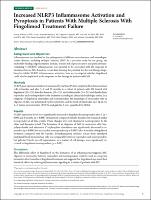| dc.contributor | Vall d'Hebron Barcelona Hospital Campus |
| dc.contributor.author | Hurtado Navarro, Laura |
| dc.contributor.author | Papolla, Agustin |
| dc.contributor.author | Rio Izquierdo, Jordi |
| dc.contributor.author | Montalban, Xavier |
| dc.contributor.author | Pelegrin, Pablo |
| dc.contributor.author | Comabella Lopez, Manuel |
| dc.contributor.author | Malhotra Sareen, Sunny |
| dc.contributor.author | Villar, Luisa M |
| dc.date.accessioned | 2023-03-31T07:25:11Z |
| dc.date.available | 2023-03-31T07:25:11Z |
| dc.date.issued | 2023-05 |
| dc.identifier.citation | Malhotra S, Hurtado-Navarro L, Pappolla A, Villar LMM, Río J, Montalban X, et al. Increased NLRP3 Inflammasome Activation and Pyroptosis in Patients With Multiple Sclerosis With Fingolimod Treatment Failure. Neurol Neuroimmunol Neuroinflammation. 2023 May;10(3):e200100. |
| dc.identifier.issn | 2332-7812 |
| dc.identifier.uri | https://hdl.handle.net/11351/9281 |
| dc.description | Inflamasoma; Piroptosis; Esclerosis múltiple |
| dc.language.iso | eng |
| dc.publisher | Wolters Kluwer Health |
| dc.relation.ispartofseries | Neurology, Neuroimmunology and Neuroinflammation;10(3) |
| dc.rights | Attribution-NonCommercial-NoDerivatives 4.0 International |
| dc.rights.uri | http://creativecommons.org/licenses/by-nc-nd/4.0/ |
| dc.source | Scientia |
| dc.subject | Esclerosi múltiple - Tractament |
| dc.subject | Medicaments immunosupressors |
| dc.subject | Mort cel·lular |
| dc.subject.mesh | Multiple Sclerosis |
| dc.subject.mesh | Inflammasomes |
| dc.subject.mesh | Immunosuppressive Agents |
| dc.subject.mesh | Cell Death |
| dc.title | Increased NLRP3 Inflammasome Activation and Pyroptosis in Patients With Multiple Sclerosis With Fingolimod Treatment Failure |
| dc.type | info:eu-repo/semantics/article |
| dc.identifier.doi | 10.1212/NXI.0000000000200100 |
| dc.subject.decs | esclerosis múltiple |
| dc.subject.decs | inflamasomas |
| dc.subject.decs | inmunosupresores |
| dc.subject.decs | muerte celular |
| dc.relation.publishversion | https://doi.org/10.1212/NXI.0000000000200100 |
| dc.type.version | info:eu-repo/semantics/publishedVersion |
| dc.audience | Professionals |
| dc.contributor.organismes | Institut Català de la Salut |
| dc.contributor.authoraffiliation | [Malhotra S, Pappolla A, Río J, Montalban X, Comabella M] Servei de Neurologia, Vall d’Hebron Hospital Universitari, Barcelona, Spain. Centre d’Esclerosi Múltiple de Catalunya (CEMCAT), Barcelona, Spain. Vall d’Hebron Institut de Recerca (VHIR), Barcelona, Spain. Universitat Autònoma de Barcelona, Bellaterra, Spain. [Hurtado-Navarro L] Biomedical Research Institute of Murcia (IMIBArrixaca), University Clinical Hospital Virgen de la Arrixaca, Murcia, Spain. [Villar LMM] Departments of Immunology and Neurology, Multiple Sclerosis Unit, Hospital Ramon y Cajal, (IRYCIS), Madrid, Spain. [Pelegrin P] Biomedical Research Institute of Murcia (IMIBArrixaca), University Clinical Hospital Virgen de la Arrixaca, Murcia, Spain. Department of Biochemistry and Molecular Biology B and Immunology, Faculty of Medicine, University of Murcia, Murcia, Spain |
| dc.identifier.pmid | 36973075 |
| dc.rights.accessrights | info:eu-repo/semantics/openAccess |

 Área privada
Área privada Contacto
Contacto







